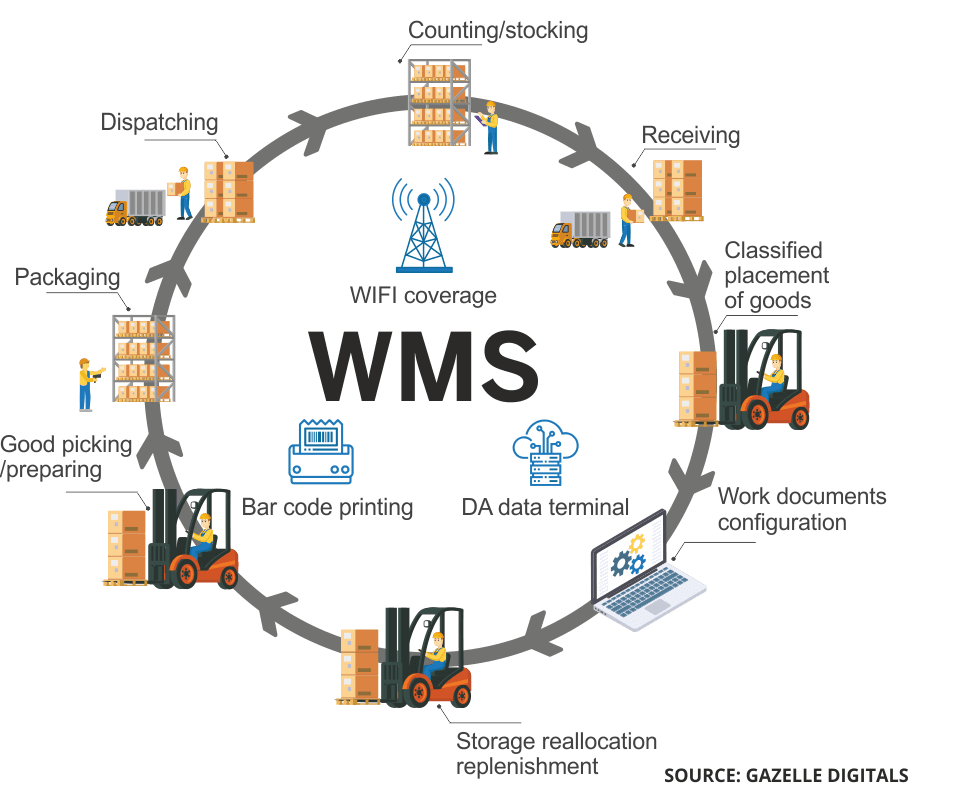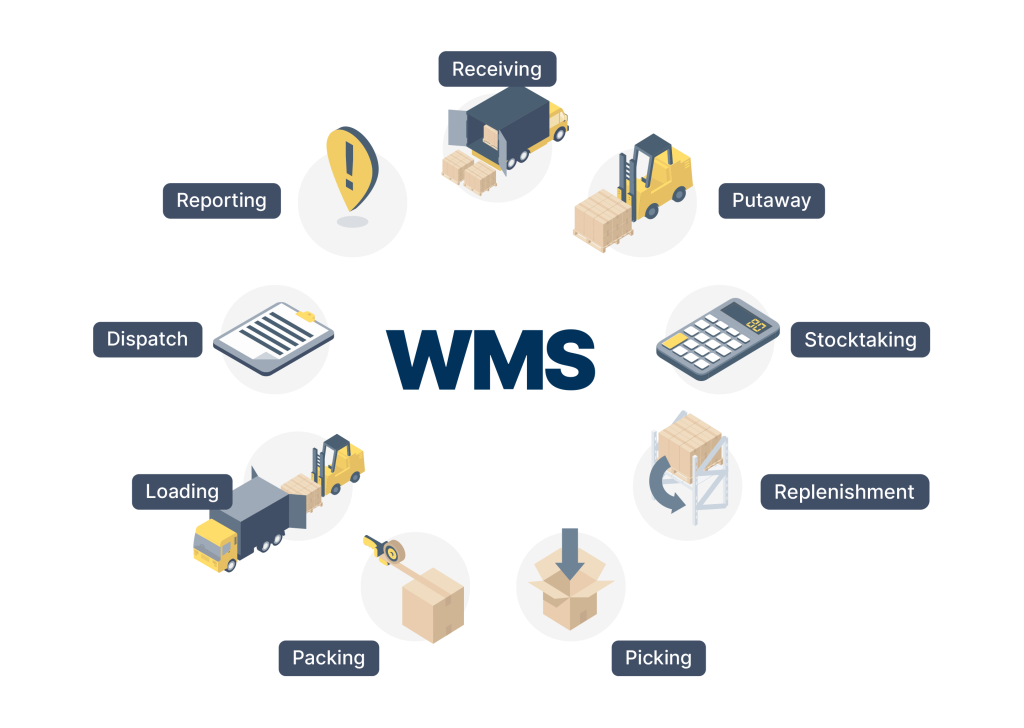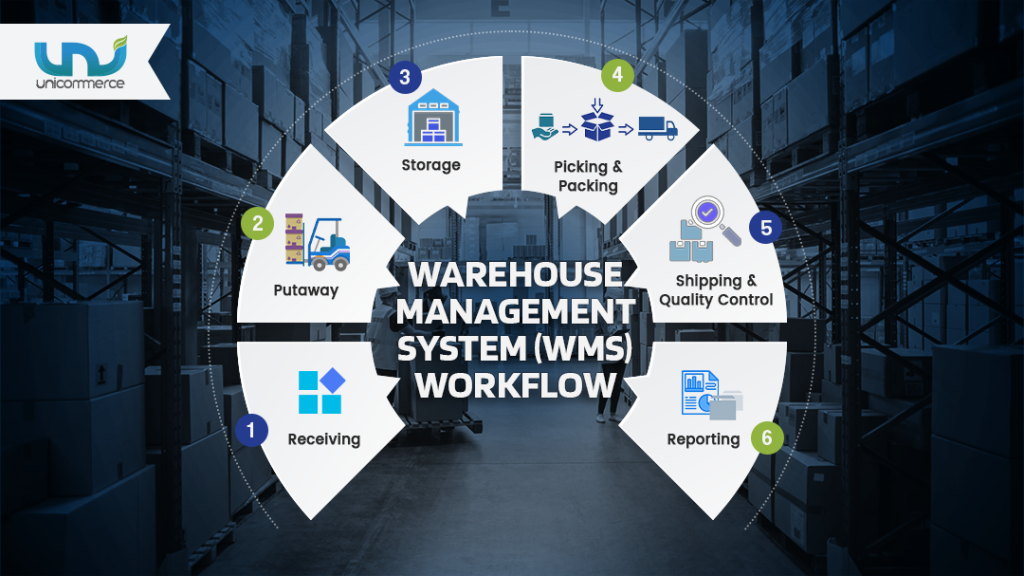Warehouse Management Systems (WMS): The Ultimate Guide to Streamlining Your Operations
In today’s competitive marketplace, managing your warehouse efficiently is crucial for meeting customer demands and optimizing operations. One of the best ways to achieve this is through a Warehouse Management System (WMS). A WMS is a software solution that helps businesses control and manage warehouse operations, from inventory management to order fulfillment.
This comprehensive guide will explain what a Warehouse Management System (WMS) is, its key features, benefits, how to choose the right system for your business, and how it can transform your warehouse operations.

What is a Warehouse Management System (WMS)?
A Warehouse Management System (WMS) is a software platform designed to optimize and manage the operations within a warehouse. It provides real-time visibility into inventory levels, order processing, and warehouse activities. By automating tasks such as inventory tracking, picking, packing, and shipping, a WMS streamlines warehouse operations and ensures efficiency.
Key Functions of a Warehouse Management System:
- Inventory Tracking: WMS allows businesses to monitor inventory levels in real-time, helping to prevent stockouts and overstocking.
- Order Fulfillment: Automates the process of picking, packing, and shipping products, reducing errors and speeding up fulfillment.
- Receiving and Putaway: Manages incoming goods and directs where they should be stored in the warehouse.
- Shipping Management: Ensures that products are shipped to customers accurately and on time.
- Reporting and Analytics: Provides data-driven insights into warehouse performance, helping to identify bottlenecks and opportunities for improvement.
How Does a WMS Work?
A Warehouse Management System works by integrating with other systems such as Enterprise Resource Planning (ERP) and Transportation Management Systems (TMS) to provide end-to-end visibility and control. It automates key functions like inventory tracking and order processing, reducing the need for manual intervention and minimizing the risk of errors.
When a customer places an order, the WMS ensures that the right products are picked from the warehouse, packed securely, and shipped according to customer requirements. It also helps monitor the movement of goods within the warehouse, ensuring that products are stored in optimal locations for easy retrieval.

Benefits of Implementing a WMS
Implementing a Warehouse Management System (WMS) offers several key benefits that can enhance the overall efficiency of warehouse operations. Here are some of the most notable advantages:
1. Increased Efficiency
A WMS automates various warehouse processes, reducing the need for manual labor and human intervention. This leads to faster order processing, reducing lead times and improving overall warehouse efficiency.
2. Better Inventory Control
By providing real-time visibility into inventory levels, a WMS helps businesses optimize stock levels and reduce the chances of overstocking or stockouts. It can also track product movement, expiration dates, and storage conditions.
3. Improved Accuracy
With a WMS, the likelihood of errors in inventory management, order picking, and shipping decreases significantly. Barcode scanning, RFID, and automated order processing help ensure that the right products are shipped to the correct customers.
4. Cost Savings
A WMS can help reduce operational costs by minimizing the need for manual processes, optimizing warehouse space, and improving labor productivity. It also enables better demand forecasting and inventory management, leading to cost reductions.
5. Enhanced Customer Service
Faster order fulfillment and accurate shipping lead to higher customer satisfaction. A WMS allows businesses to offer real-time tracking information, keeping customers informed about the status of their orders.
6. Scalability
As your business grows, so do your warehouse needs. A WMS can scale with your operations, accommodating higher order volumes, additional warehouses, and new product lines without a significant increase in labor costs.

Key Features to Look for in a WMS
When selecting a Warehouse Management System (WMS) for your business, it’s essential to understand the key features that can drive value. Here are some critical features to consider:
1. Real-Time Inventory Visibility
Look for a WMS that offers real-time tracking of inventory levels across multiple locations. This will help you reduce stockouts and ensure that you always have the right amount of stock on hand.
2. Mobile Accessibility
Mobile capabilities are crucial for improving warehouse flexibility. A WMS that integrates with mobile devices like barcode scanners and tablets allows warehouse workers to update inventory and process orders on the go.
3. Integration Capabilities
Your WMS should integrate seamlessly with other systems like your ERP and TMS. This integration ensures smooth data flow across various departments, improving efficiency and minimizing errors.
4. Order Management
Look for a WMS that offers advanced order management features, such as the ability to handle multiple order types, track backorders, and manage returns effectively.
5. Customizable Dashboards and Reporting
A good WMS provides customizable dashboards that give real-time insights into warehouse performance, such as order statuses, inventory levels, and employee productivity. It should also offer robust reporting features for data analysis.
6. Automated Picking and Packing
Advanced WMS solutions often feature automated picking and packing functionalities that reduce manual labor and increase picking accuracy.
Choosing the Right WMS for Your Business
Selecting the right Warehouse Management System depends on several factors such as the size of your warehouse, the complexity of your operations, and your budget. Here are some essential considerations when choosing a WMS:
1. Business Size and Complexity
Smaller businesses with less complex operations may benefit from a simpler, off-the-shelf WMS solution. On the other hand, larger enterprises with multi-location warehouses and complex processes may require a more customized WMS solution with advanced features.
2. Scalability
As your business grows, your WMS should be able to grow with you. Look for a system that offers scalability in terms of both functionality and capacity.
3. User-Friendliness
A user-friendly WMS is essential for ensuring smooth adoption among your warehouse staff. Choose a system that is easy to use and offers intuitive interfaces and clear instructions.
4. Customer Support
Make sure the WMS provider offers strong customer support, including training, troubleshooting, and updates. Access to timely support can prevent downtime and ensure your warehouse runs smoothly.
5. Cost
While advanced WMS systems offer powerful features, they may come with higher costs. Evaluate your budget and look for a solution that offers the best balance of features and price for your business needs.
WMS Implementation: Best Practices
Implementing a Warehouse Management System can be a significant undertaking, but with proper planning and execution, it can lead to dramatic improvements in warehouse operations. Here are some best practices for successful WMS implementation:
1. Define Clear Objectives
Before implementing a WMS, define the specific goals you want to achieve, such as improving order accuracy, reducing lead times, or increasing inventory visibility. Clear objectives will help guide your implementation process and measure success.
2. Involve Key Stakeholders
Involve key stakeholders such as warehouse managers, IT staff, and inventory managers early in the process. Their insights and expertise will help ensure that the WMS meets operational needs and integrates seamlessly with existing processes.
3. Test the System Thoroughly
Before going live, conduct extensive testing to ensure the system works as expected. Test key features such as order fulfillment, inventory tracking, and system integration to identify potential issues before they affect your operations.
4. Provide Adequate Training
Ensure that your staff is properly trained on how to use the new system. A comprehensive training program will help minimize disruptions and ensure that employees are comfortable with the new technology.
FAQ: Warehouse Management Systems (WMS)
Q1: What industries can benefit from using a WMS?
A1: Any industry that requires efficient inventory and warehouse management can benefit from a WMS. Common industries include e-commerce, manufacturing, retail, pharmaceuticals, and food distribution.
Q2: Is a WMS compatible with my existing ERP system?
A2: Most modern WMS systems are designed to integrate with a wide variety of ERP and TMS solutions. It is important to verify compatibility with your current software before implementation.
Q3: How long does it take to implement a WMS?
A3: The implementation time for a WMS varies depending on factors such as the complexity of your operations, the size of your warehouse, and the customization needed. Generally, implementation can take anywhere from a few weeks to several months.
Q4: How much does a WMS cost?
A4: The cost of a WMS depends on factors such as the software’s features, the size of your operation, and whether it’s cloud-based or on-premise. Prices can range from a few thousand dollars for basic systems to tens of thousands for more advanced, customized solutions.
Conclusion
A Warehouse Management System (WMS) is an essential tool for modern warehouses looking to improve efficiency, accuracy, and customer satisfaction. By automating inventory management, order fulfillment, and other key processes, a WMS can transform your warehouse operations and provide significant cost savings.
By
selecting the right WMS, integrating it with your existing systems, and following best practices for implementation, you can take your warehouse operations to the next level.
To learn more about Warehouse Management Systems and explore top-rated solutions, check out the following resources:
– OptiPro ERP – Warehouse Management Systems
– Best Software for Warehouse Management

